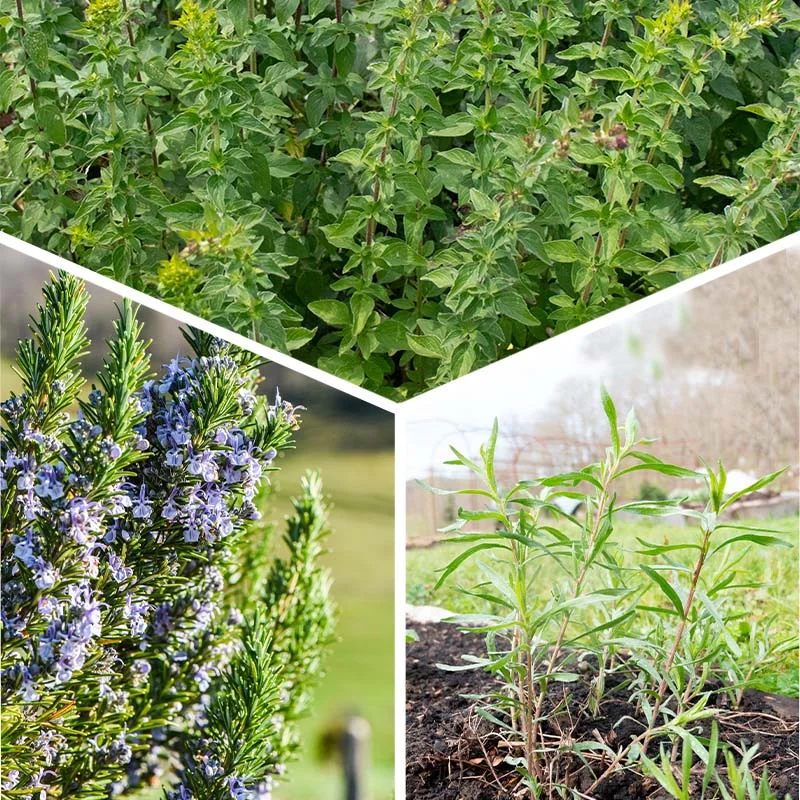Aromatics 3 plants "Aromatiques de Provence" AB
Invite your senses on a journey with this trio of aromatic plants featuring tarragon, savory and oregano, ideal for enriching your cooking with exquisite aromas and fragrances. Whether you grow them in a pot or in the ground in your garden, these herbs will provide a palette of tasty herbs essential for enhancing and enlivening all your cooking recipes. Create your own herb and condiment garden with these perennials, for an unrivalled taste experience.
- Tarragon
Tarragon, sometimes called dragon's herb, belongs to the greater sagebrush family and can grow up to 1 m tall. It offers generous, smooth, glossy dark-green foliage, highly aromatic with a sweet aniseed flavor, and in late summer reveals a multitude of small, discreet, gray-green pompon-shaped flowers. Tarragon is a perennial shrub that can be grown in the ground, in large pots or in containers.
- Mountain savory
Mountain savory, or perennial savory, is a small sub-shrub 30 to 40 cm high. It has narrow, elongated leaves with a pungent, peppery flavor, more aromatic than those of common savory. It displays a multitude of small white flowers, attracting bees and bumblebees from July to September. Hardy, it is equally at home in the garden or on the balcony.
- Oregano
Oregano, a perennial, is equally at home in the vegetable garden, tub or window box. Its plants can grow up to 80 cm tall, with branched stems featuring small, rounded, highly aromatic leaves that are the stars of Mediterranean cuisine. In summer, it is adorned with a myriad of slender, melliferous pink to purple flowers in panicles. Long confused with marjoram, Origanum majorana, it is sometimes known as wild marjoram or perennial marjoram.
Tarragon: cultivation & uses in cooking
Tarragon thrives in light, cool, humus-rich but well-drained soils, and in sunny locations sheltered from cold winds and frosts.
Transplant tarragon plants in early autumn or spring, after the last frosts, 30 to 40 cm apart in all directions. Mulch the plants to keep the soil cool, and pinch off the flower stalks as soon as they appear to stimulate leaf development. At the end of the season, cut back the tarragon plants and mulch the base to protect the roots from the cold.
Divide tarragon plants every 2 to 3 years to give them more vigor.
Renowned for its distinctive fragrance and sweet, delicately aniseed flavor, tarragon has a thousand and one uses in the kitchen. Indispensable for preparing the famous Béarnaise sauce, it can be used to enhance all recipes for salads, sauces, chicken, fish and more.
Along with parsley, chervil and chives, tarragon is one of the 4 traditional herbs used in omelette and fromage frais recipes.
This herb is also used in phytotherapy to stimulate the appetite, aid digestion, promote sleep, regulate and trigger menstruation, etc., and in aromatherapy for its neuromuscular antispasmodic, anti-inflammatory, anti-infectious, antiviral and antibacterial properties.
Mountain savory: cultivation & culinary uses
Mountain savory grows naturally in very arid areas, in full sun, on dry, stony soils. It therefore particularly appreciates well-drained soil and sunny exposure. Lighten heavy or compacted soils with sand or pebbles.
Transplant savory plants in early autumn or spring, after the last frosts, 20 to 30 cm apart in all directions. Thereafter, no special maintenance is required.
Cut back the plants at the end of the season and mulch to protect the roots from the cold.
Mountain savory, with its powerful aromatic scent and warm, pungent flavor, is used both in cooking and medicine. Fresh or dried, it flavors and enhances all dishes, cheeses, sauces and more. Traditionally, this herb is used in the preparation of many bean and lentil dishes to aid digestion.
It also offers a wide range of medicinal properties: broad-spectrum anti-infective, immunomodulating, physical and nervous stimulant, endocrine stimulant, anti-inflammatory, percutaneous analgesic, digestive, carminative, intestinal antiputrid, expectorant, antioxidant, healing, etc.
Oregano: cultivation & uses in cooking
Oregano is easy to grow in the garden or in pots, and is resistant to both cold and drought. It particularly likes dry, chalky, poor soil and sunny exposure.
Transplant common oregano in early autumn or spring, after the last frosts, 30 cm apart in all directions. Cultivation requires no specific maintenance, apart from a few waterings for plants in window boxes or pots.
At the end of the season, cut back the plants and mulch to protect the roots from the cold. Oregano resprouts and suckers abundantly.
Oregano, with its aromatic scent similar to that of thyme or wild thyme and its warm, bitter, pungent flavor, has been used in cooking and medicine since Antiquity. Like thyme, rosemary, savory and basil, it is one of the herbs of Provence. Its leaves, fresh or dried, can be used to flavour and enhance all kinds of vegetables, sauces, meats, pastas, vinaigrettes, etc., and especially pizzas!
Oregano also has analgesic, anti-infectious, antiseptic, antibacterial, antioxidant, antispasmodic, aperitive, digestive, diuretic and tonic properties.
Aromatic assortment shipping and delivery
- Orders are dispatched Monday to Thursday.
- Shipment to mainland France only.
- Shipping cartons designed for optimal plant protection.
- Free shipping does not apply to plants.










